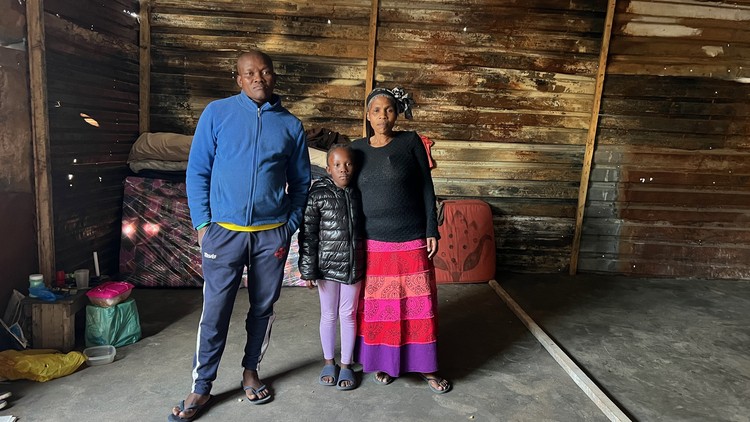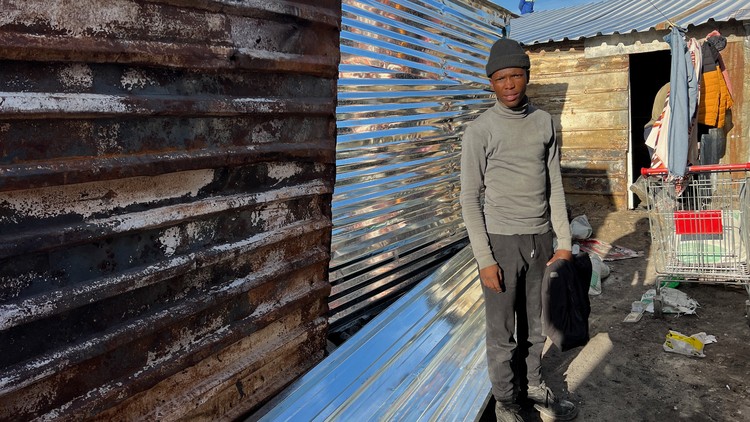No ID, no vote: Home Affairs fails victims of Cape Town shack fire
Home Affairs says the City of Cape Town must send a list of victims but the City says it’s already done so
Zolile and Nomagirls Qina, seen here with their daughter, Asanda, lost their belongings in a shack fire. They have partly rebuilt their shack, but without their IDs, they will not be able to vote. Photos: Peter Luhanga
- Some voters who lost their IDs in a fire in Doornback informal settlement in Cape Town earlier this month will not be able to vote on Wednesday.
- The Department of Home Affairs blamed the City of Cape Town for not sending in a list of those needing temporary IDs.
- But the City said it did send the list and provided a reference number.
A devastating fire in Doornbach informal settlement, Cape Town, on 6 May, destroyed 150 shacks and left 360 residents without homes. Many people also lost their identification documents in the blaze. Without IDs, they will not be able to vote in Wednesday’s elections.
The Department of Home Affairs, which usually deploys a mobile unit to provide temporary IDs in such crises, has not yet done so. Some victims of the fire can’t afford the R42 return taxi fare to the nearest Home Affairs office in Cape Town.
For Zolile Qina it will be the first time since 1994 that he will not be voting. His three-bedroom shack, which shared with his wife and five children, was reduced to ashes, along with almost all his belongings, including his ID. He managed to save only three bags of clothes.
“It is not nice not to be able to vote when everyone is voting,” he said. Yet he is not optimistic that voting would change his life.
He has been living in Doornbach since 2000. He says the living conditions are filthy, with residents sharing their homes with rats and flies because rubbish is not collected.
“We vote with the hope that our quality of life will change, but there is nothing that changes,” he says.
“We just vote for the sake of voting. It does not improve the quality of our living conditions,” says Qina’s wife, Nomagirls. She began voting in 1999, but like her husband she lost her ID in the fire and won’t be voting this time.
Mbuyisi Yawa also lost everything, including his ID, in the fire that destroyed the one-room shack he shared with his brother. He said they had expected the mobile unit from Home Affairs to issue temporary IDs but this never happened.
“I’ll not exercise my right to vote. Even voting does not help me. I do not see the benefit,” says Yawa, who says he usually voted ANC.
Mbuyisi Yawa lost everything including his ID in the fire.
A preacher at the Saint Johns Church in Dunoon, Mzwakhe Bekapi, says he sent a list of 31 people who lost their IDs to the Department of Home Affairs, but his efforts did not yield any results.
Home Affairs spokesperson Siya Qoza told GroundUp on Monday that the City of Cape Town had to submit a list of the fire victims to the department. “It is a standard procedure. It starts with the City when the disaster happens.” He said he was not aware of any request from the City.
But Charlotte Powell, the City’s Disaster Risk Management spokesperson, said she had found evidence that the City had reported the incident and sent a full list of victims including names of children and copied it to four officials at the Department of Home Affairs, with reference number SR33235.
GroundUp sent the reference number to Qoza, who promised to check whether it had been received. “I will check if we have it on our records.”
But the process would take a while, he said.
Support independent journalism
Donate using Payfast

Don't miss out on the latest news
We respect your privacy, and promise we won't spam you.
Next: KZN budget cuts hit childcare organisations hard
Previous: Gauteng Premier breaks promise to pay organisations by 24 May
© 2024 GroundUp. This article is licensed under a Creative Commons Attribution-NoDerivatives 4.0 International License.
You may republish this article, so long as you credit the authors and GroundUp, and do not change the text. Please include a link back to the original article.
We put an invisible pixel in the article so that we can count traffic to republishers. All analytics tools are solely on our servers. We do not give our logs to any third party. Logs are deleted after two weeks. We do not use any IP address identifying information except to count regional traffic. We are solely interested in counting hits, not tracking users. If you republish, please do not delete the invisible pixel.


